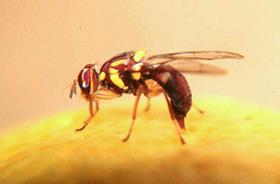
The world’s first dedicated Queensland fruit fly (Qfly) sterile insect treatment (SIT) research facility is on track to be finished before the end of the year, with major benefits on the way for growers battling the damaging fly.
Based in Port Augusta in South Australia, the SITPlus research centre will be home to research and development of producing sterile male fruit flies, which will then be strategically released into Qfly affected areas to diminish the population of wild male fruit flies. In turn, this will disrupt mating, meaning growers can reduce pesticide use to manage.
The five-year project has received A$45m in investments from Horticulture Innovation Australia with co-investment from Macquarie University, CSIRO, NSW Department of Primary Industries, SARDI/PIRSA, Plant and Food Research Australia and the Australian government.
Dan Ryan, programme director of SITplus, told Fruitnet that estimates put the cost of Qlfy to Australian producers at around A$300m a year in lost production, lost markets and costs of management.
This new programme, Ryan said, will not only benefit local producers in keeping down costs and increasing their ability to trade fruit interstate, but in the longer term could also work to benefit exporters by giving overseas trading partners the confidence that they’re purchasing fruit fly-free produce.
“One of the advantages of SIT is that you can release the sterile fruit fly males aerially so that have an impact on those areas without bait,” Ryan added. “It helps address the perennial issues of abandoned orchards and properties were people have orchards that haven’t been managed properly.”
One of the major wins has been the development of a gel feed – the first of its kind in the world – which will reduce both labour and waste at the facility.
While there are some 25 fruit fly SIT facilities around the world, the majority concentrate on Medfly, and with Qfly being unique to Australia, Ryan said its “us or no one else” when it comes to developing a SIT programme for this genus.
“We’ve travelled to Israel, Spain, Central American and the US to look at a range of other SIT facilities – from the factories, to the distribution, to how the business is run, and we tried to bring those ideas back to Australia,” Ryan said. “The benefit of being a late adopter is that we don’t repeat their mistakes, and we learn from what they’ve done before.”
And why has it taken so long for a Qfly SIT programme to get off the ground in Australia?
“The planets haven’t aligned,” Ryan said. “For a long time, fenthion and dimethoate were used to manage fruit fly [which have now been phased out for use in Australia], and there was perhaps a lack of high level government investment – A$45m is a big investment and that was one of the big hurdles in the past.”
While at the moment the funding is coming from partners, Ryan said they are looking at finding a commercial operate to run the facility.
“We want someone to invest in the running of the factory; someone who can operate it effectively and efficiently,” Ryan said. “Through our overseas research and careful planning, we’ve produced a facility that can bring efficiencies – the gel feed alone reduces the number of staff needed, and cuts waste.
“This is a really exciting programme,” Ryan added. “This kind of large, focused, multi-institute programme is new in horticulture in Australia and it’s going surprisingly well.”
Thisarticle originally appeared inthe July/August edition of Asiafruit and the spring edition of Produce Plus



